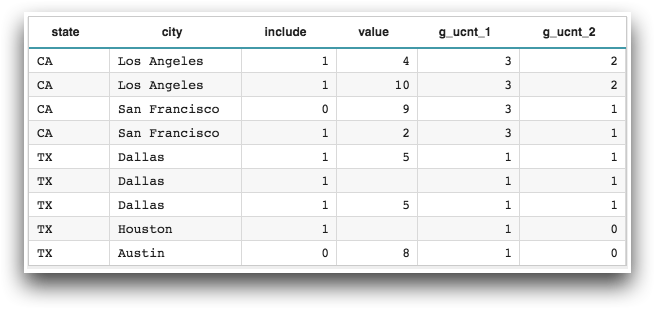g_ucnt(G;S;X)
Returns the number of distinct values within a given group.
Function type
Vector only
Syntax
g_ucnt(G;S;X)Input
| Argument | Type | Description |
|---|---|---|
G |
any | A space- or comma-separated list of column names Rows are in the same group
if their values for all of the columns listed in If If any of the columns listed in |
S |
integer | The name of a column in which every row evaluates to a 1 or 0, which determines
whether or not that row is selected to be included in the calculation If
If any of the values in
|
X |
any simple type | A column name N/As in |
Return Value
For every row in each group defined by G (and for those rows where
S=1, if specified), g_ucnt
returns the integer value corresponding to the number of distinct values in the column
listed in X that are in the same group as that row.
If all values for a particular group are N/A, the result is 0.
Sample Usage
<base table="pub.doc.samples.ref.func.g_func_sample_usage"/> <willbe name="g_ucnt_1" value="g_ucnt(state;include;value)"/> <willbe name="g_ucnt_2" value="g_ucnt(state city;include;value)"/>

Example
Let's say we want to know how many unique transactions occurred at every store in our Sales Item Detail table (pub.demo.retail.item).
<base table="pub.demo.retail.item"/>Create a computed column using the g_ucnt(G;S;X)
function. Specify store as the group
(G), since we're grouping by store; specify
transid as X since we want
the number of unique transactions; and leave the selection parameter
(S) blank, since we want to take into
account all of the transactions (not just a subset of those
transactions):
<willbe name="numtrans" value="g_ucnt(store;;transid)" label="# of Unique`Transactions"/>Since we didn't specify a selection column, the numtrans
column will show the total number of unique transactions for every
store.
Now let's see if we can find out how many unique transactions occurred at
each store between 6/1/2012 and 6/30/2012. We essentially want to
find out the same information, but for a subset of our data. For
this, we can use the selection column parameter of the
g_ucnt(G;S;X) function.
Create a computed column that evaluates to true if the transaction date falls between those dates:
<willbe name="in_june" value="between(date;'6/1/2012';'6/30/2012')" label="In June"/>Now, use the in_june computed column as the selection
column in the g_ucnt(G;S;X) function:
<willbe name="numtrans_in_june" value="g_ucnt(store;in_june;transid)" label="# of Unique`Transactions`In June"/>The numtrans_in_june column shows the total number of
unique transactions that occurred between 6/1/2012 and 6/30/2012 for
every store.
